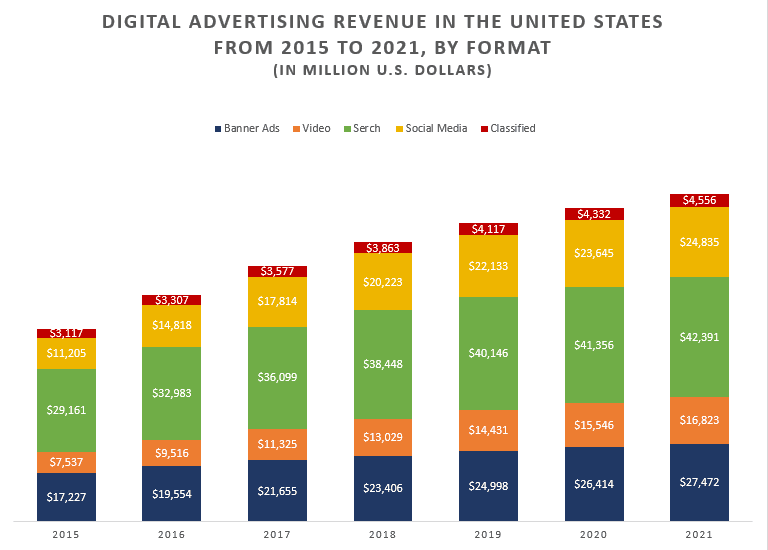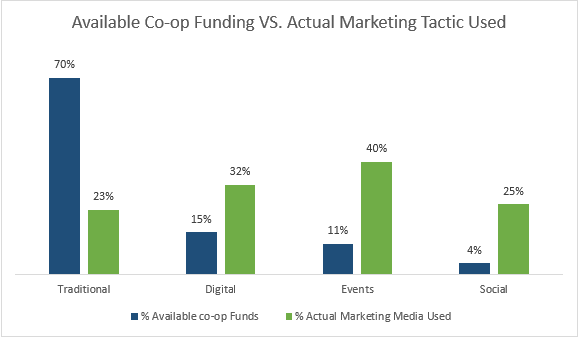Digital Co-op Advertising – Revolutionize your Co-op Program.
Year-after-year the use of digital advertising and the revenue generated from utilizing this form of advertising continue to grow. Many national brands have recognized the value of digital marketing by investing in digital for national exposure. However, on the local level, vendors and the sector of the market that relies on co-op marketing funds are still reluctant in adopting and integrating digital co-op advertising into their marketing campaigns.
As it is, co-op programs are complex to comprehend and manage. Therefore, adding a digital component to an already multifaceted marketing system is not widespread in the channel. Many believe that digital co-op advertising programs are slowing down the adoption of digital media advertising in the channel.

In the channel, many local marketers still rely on legacy media to use their co-op funds. In a survey of local marketers, published by LSA, the top 5 most used advertising medium used for co-op are:
- Newspapers
- Yellow Pages
- Out-of-home/Billboards
- Radio
- Direct Mail
70% of all available co-op advertising dollars are still used in legacy media, 19% in digital media and 11% is dedicated to local events.
Source: Brandmuscle

Nevertheless, more than 90% of vendors are making an effort to join the digital advertising ecosystem. Such vendors are updating their co-op rules to persuade their partner the use of digital media in their co-op advertising.
A few forms of digital advertising that are widely known to be used in co-op advertising are:
- Email marketing
- Display advertising
- Paid search advertising
For the longest time vendors viewed the local market unreachable. Traditionally, vendors used co-op advertising programs to attract consumers to local merchants. However, with digital, vendors have discovered a flood of opportunities to get in front of consumers. By equipping their channel partners with the funds and tools to run their digital co-op programs, vendors gain the opportunity to effectively engage with local customers.
3 Main Barriers to Digital Co-op Advertising and How to Make Digital Work
The 3 main barrier to digital co-op advertising are:
1- Complexity and Variety of Digital Mediums
The digital media’s fast-paced changes and the overwhelming number of new platforms are considered by many vendors and their partners as barriers to adopting digital media for advertisement. In addition, the amount of knowledge and continuous learning required to run a digital advertising campaign are considered challenging barriers.
However, as mentioned above and illustrated in diagram 2, many partners are utilizing digital media in their local marketing campaigns. According to Brandmuscle, 57% of local partners are managing their own digital marketing campaigns. Yet, these partners struggle to maintain and manage their marketing efforts. Therefore, to assist these partners and those who are not utilizing digital marketing, vendors need to furnish their partners with tools and resources to harness the true value of digital advertising.
Advantages of Digital
Digital advertising is trackable, measurable, and more efficient. Providing partners with automated synchronized channel marketing tools such as MioDatos gives vendors the ability to effectively engage with consumers on a local level. In addition, restructuring and automating your co-op advertising programs with data-driven features help partners save time creating and managing their digital advertising efforts.
Supporting partners in their digital marketing can help them measure their local marketing efforts. Conversely, vendors can apply what they have learned from these marketing efforts to their network of partners.
2- Lack of New Guidelines for Digital Co-op Advertising
There are still some vendors who are practicing out-dated co-op advertising program rules. Digital brings a new opportunity for vendors to re-create their co-op programs to reflect the current changes in consumer behavior and advertising. However, the lack of guidelines for a digital co-op advertising campaign has resulted in an inconsistency in the brand’s online messaging.
Therefore, in their new co-op guideline, vendors need to specify program instructions that encompass the use of digital platforms that make strategic sense for their brand and partners. It is important that vendors resort to tactics that generate the best results for their partners. At the same time, these vendors need to provide funds and co-branded materials to optimize local marketing. Mobile, paid per click (PPC), and social media are currently the best online tools for capturing the local consumers. However, in using these digital platforms, vendors need to offer their partners tactics that reflect the vendor’s national marketing approach. In doing so, the vendor’s national and local digital campaigns will form a consistent consumer experience.
Advantages of Automation
Again, using an automated co-marketing platform such as MioDatos will provide partners with pre-approved materials containing the vendor’s logo and trademark, vendor’s tagline, colors, typeface, different templates, and all miscellaneous legal terms.
49%
of local businesses learn about available Co-op/ MDF dollars by logging into their marketing platform
45%
of local businesses didn’t use their Co-op/ MDF funds last year
52%
of local businesses did not receive adequate training on their Co-op/ MDF program
43%
will increase spending in digital, social (40%), and events (40%) while traditional spending plans to remain the same (68%) in 2018
Source: Brandmuscle 2018
3- Verifiable Tracking System
Practically every co-op program requires a proof of performance. With digital co-op advertising, a reliable tracking is needed to show proof of impression, reach, and delivery. Today, there are many 3rd party co-op program management companies. SaaS companies, like Computer Market Research, have expanded into digital to help fulfill vendor’s program requirements and provide support for running a digital co-op campaign. These companies use tracking data to verify proof of performance, brand integrity, and measure program compliance.
When national digital ad campaigns are localized, vendors are able to learn the highest converting ad initiative and apply that plan to boost sales by geographical location.
Experience the Power of Automation
By removing the complexities associated with a channel, Computer Market Research is reinventing the way a business manages its channel relationships. As a result, companies are able to use and automated partner relationship management application designed around their business rules.
For customers needing modular solutions, CMR’s comprehensive software provides unmatched flexibility and scalability. This allows customers to build the most optimized platform to manage their channel.
Customer-centric companies are 60% more profitable compared to companies that are not focused on the customer.
Source: Deloitte and Touch
Synchronized Channel Marketing – MioDatos
Over the years, we’ve learned that vendors have difficulty reaching the end customer while maintaining consistent messaging through their partners. The challenges these vendors faced were keeping consistent marketing messages, controlling their corporate identities and continuously motivating the resellers to put forth marketing efforts.
However, on the partner side, we learned that partners don’t have the resources or tools to market themselves or their vendors. Partners’ biggest challenges are time and creating engaging content. Therefore, partners do little to no marketing for their vendors or themselves.
With Computer Market Research’s Synchronized Channel Marketing software vendors are able to:
- Create marketing material for partners
- Integrate their content into co-branded digital campaigns
- Distribute their marketing material to channel partner’s digital network
Co-op/MDF Management
Our Co-op/MDF Management module provides unmatched visibility on channel spending for improved ROI. This web-based tool enables you to operate your Co-op and MDF programs on a global scale. Our Co-op/MDF solutions are entirely configurable. This allows channel management teams to build and deploy their own marketing programs that support their unique program guidelines.